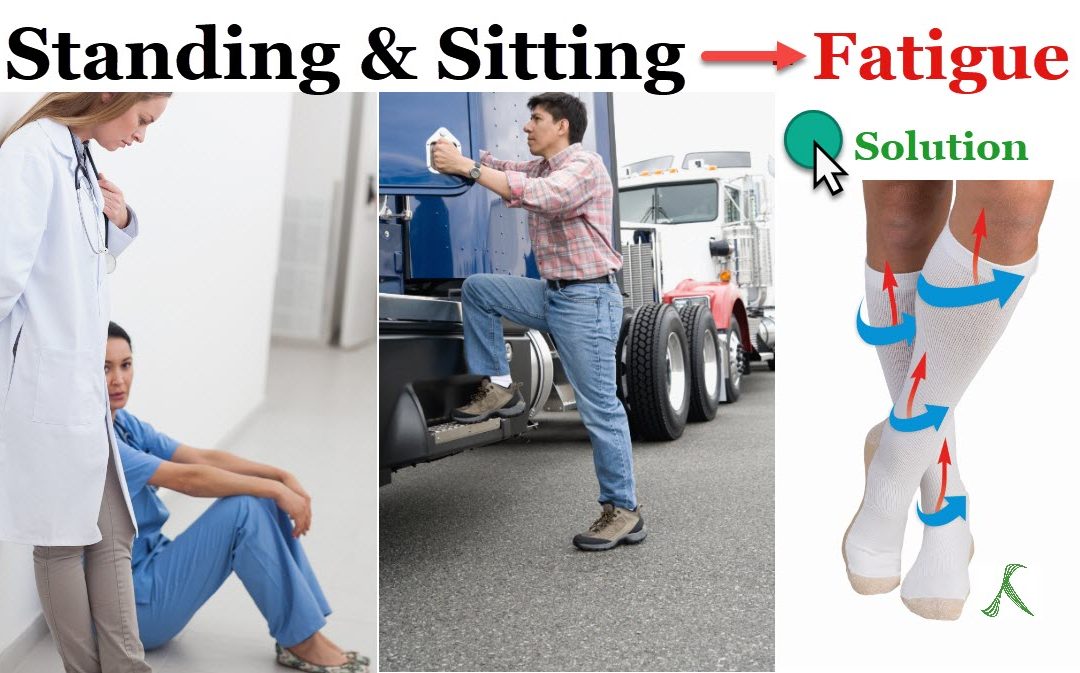Workplace hazards of Prolonged Standing and Sitting are not a new phenomenon, however, our understanding of the body’s physiological responses and ergonomic solutions is expanding. The perception of worker fatigue following a workday requiring prolonged postural demands has long been misunderstood and incorrectly addressed with environmental solutions having little to no physiological benefit for the individual worker. Compounding the issue is the fact that the health risks associated are often only experienced later in life and may not show up on a corporate radar as compensable risks. Fortunately, cutting-edge corporate wellness & injury prevention programs have discovered the benefit of mitigating both workplace injuries & illnesses by implementing Fatigue Management Solutions.
Prolonged postures stress both our cardiovascular and lymphatic systems. Gravity dependent hydrostatic pressure will increase with distance between our feet and heart. Measured at the feet outward venous pressures in alternate postures are as follows:
- Standing 70 – 80 mmHg
- Sitting 45 – 60 mmHg
- Walking 25 – 30 mmHg
- Lying Down ~ 5 mmHg
The pressure on our veins ( a valve system ) result in increased filtration of interstitial fluids which are to be removed by our lymphatic system ( a movement based system ), however, prolonged postural exposures may exceed the abilities of our venous and lymphatic systems to keep up. These contributing factors result in reports of increased swelling ( Oedema ), discomfort, and fatigue following prolonged periods of postural work demands. The noted variance of pressure between walking and sit/standing result from the benefit of a muscular-venous pump action. The significant drop in pressure when lying down is exactly why we feel relief when raising our feet after a long day at work, or even after a long drive.
Per the Occupational Safety & Health Administration (OSHA) Prolonged Standing and Prolonged Sitting are workplace hazards that reduce blood flow to the legs, force isolated muscles to work for an extended time, and increases the risk of fatigue and venous disease. Solutions offered to date, advertised as “anti-fatigue”, have lacked evidence of improving the physiological work demands. Alternatively, the physiological benefits of using compression socks has been proven and demonstrated preference over fatigue matting. On Site Therapy’s Performance Socks are designed for the work environment. As the hydrostatic pressure in the lower leg increases, the gradient compression levels of 15-20 mmHg are ideal for aiding the venous and lymphatic return.
REFERENCES:
Krijnen, R., de Boer, E., Adèr, H., Osinga, D., & Bruynzeel, D. (1997, September). Compression Stockings and Rubber Floor Mats: Do They Benefit Workers With Chronic Venous Insufficiency and a Standing Profession? Journal of Occupational & Environmental Medicine, 39(9), 889-894.
McCulloch, J. (2002). Health risks associated with prolonged standing. Work, 19, 201-205.
Occupational Safety and Health Administration. (1991). Ergonomics: the Study of Work. Washington, DC: US Government Printing Office.
Standen, E. (2000). Dynamic leg volume changed when sitting in a locked and free floting office chair. Ergonomics., Vol 43, No. 3., 421-433.
Sudoł-Szopińska, I. B. (2011). Prevalence of Chronic Venous Disorders Among Employees Working in Prolonged Sitting and Standing Postures. International Journal of Occupational Safety and Ergonomics (JOSE)., 17, No. 2., 165-173.




 We take your security seriously. Your information is secured by Comodo SSL.
We take your security seriously. Your information is secured by Comodo SSL.